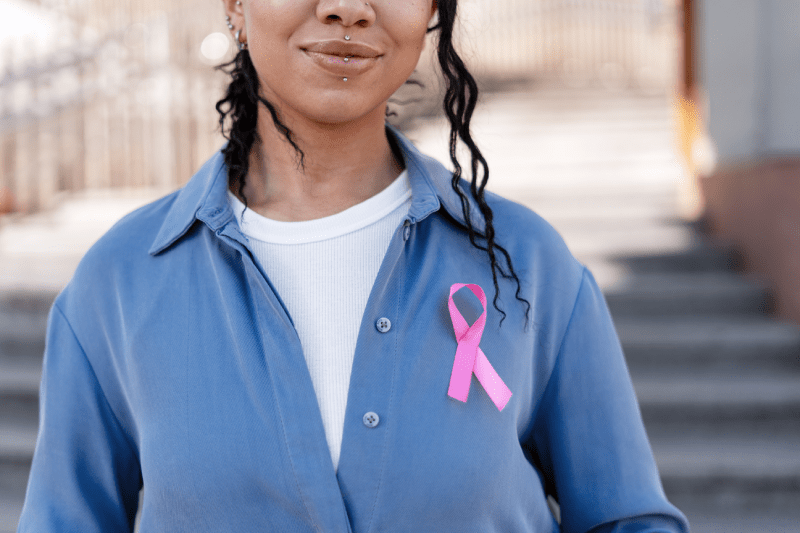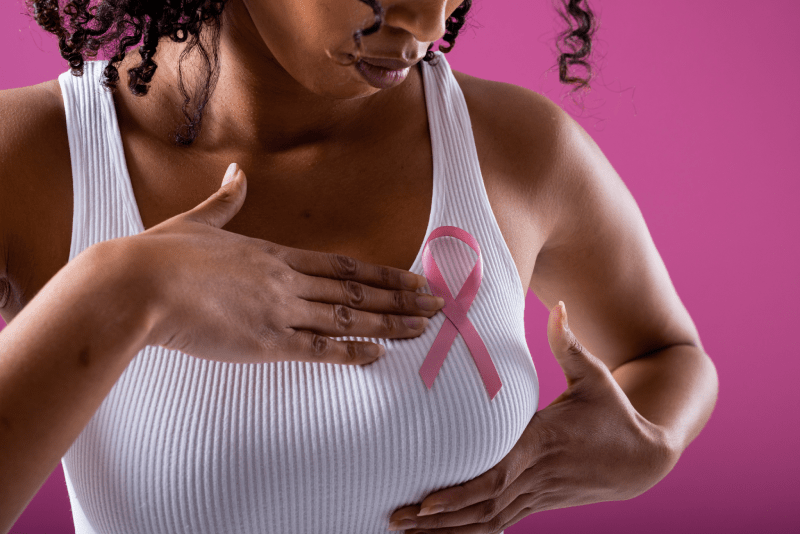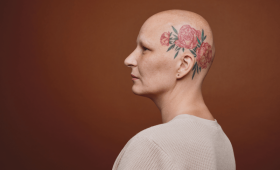Breast Cancer How Do I Know Guide
Breast cancer is a disease where the success of treatment and survival rates increase dramatically when detected early. For women, knowing the normal structure of the body, taking any change in breast tissue seriously, and complying with regular screening programs are the most effective protective measures in this vital process. Turkey offers services at international standards in breast cancer diagnosis and treatment with its modern oncology centers, advanced imaging technologies, and expert health professionals. This guide provides detailed answers to 35 fundamental questions about early diagnosis and symptoms.
What Is The Most Common Symptom Of Breast Cancer?
The most common symptom of breast cancer is usually a hard, painless lump or swelling felt in the breast or armpit. These masses often have irregular borders and are immovable. Although not every lump is cancer, seeking medical attention immediately when such a firmness is noticed is critical for early diagnosis. The lump is the most common finding of breast cancer and can be detected even in the early stages with correct diagnostic methods (mammography, ultrasound). Therefore, monthly self-breast examination should not be neglected.
Does A Lump Felt In The Breast Indicate Cancer?
Not every lump felt in the breast means cancer; most often, these are benign cysts, fibroadenomas, or hardening due to hormonal changes. Cysts are usually soft, movable, and related to the menstrual cycle, while cancerous masses are generally hard, immobile, and have ill-defined borders. However, definitively distinguishing whether a lump is benign or malignant is not possible only with a physical examination. The use of advanced diagnostic methods such as mammography, ultrasound, and, if necessary, biopsy is absolutely necessary for definitive diagnosis, which ensures a quick transition to the correct treatment.
In Which Cases Is Nipple Discharge A Cause For Concern?
Nipple discharge is a cause for concern and may be a sign of cancer, especially if it is coming from a single duct, is clear, red (bloody), or brown in color, and occurs spontaneously without squeezing the breast. Greenish or milky discharge is usually associated with hormonal imbalances or benign conditions. Since bloody discharge may be a sign of a serious condition like ductal carcinoma in situ (DCIS) or invasive cancer, pathological examination must be performed. Characteristics such as the color, consistency, and whether the discharge comes from one or both breasts are important clues for doctors in the diagnostic process.
How Is Nipple Shape Change Recognized?
A change in nipple shape is recognized by the nipple, which is normally everted, pulling inward (retraction), or a noticeable difference in its position or symmetry. This retraction may occur because the tumor pulls on the ducts or connective tissue beneath the nipple towards itself. Especially a new, permanent inward pulling that appears later is an important warning sign for cancer. Scaling, redness, or ulceration on the skin around the nipple is also a condition that should be carefully evaluated.
What Does The Orange Peel Appearance On Breast Skin Mean?
The orange peel (Peau d’Orange) appearance seen on the breast skin is a serious symptom where swelling and thickening of the skin occur due to blockage of the lymphatic vessels by cancer cells. This condition is often associated with an aggressive type of breast cancer known as Inflammatory Breast Cancer (IBC). The orange peel appearance may occur along with redness, increased warmth, and rapidly increasing swelling in a specific area of the breast. When such a skin change is noticed, an oncologist must be consulted urgently because these types of cancers can progress quickly.
Why Is Swelling In The Armpit Lymph Nodes Important?
Swelling in the armpit lymph nodes may be a normal reaction to an infection in the body, or it may be the first sign of the spread of breast cancer cells (metastasis). Breast cancer tends to spread to the lymph nodes in the armpit via the lymphatic system. These swellings are usually painless and hard. Even if there is no palpable lump in the breast, noticing a persistent or gradually growing swelling in the armpit is critically important for breast cancer screening and must be investigated with advanced imaging.
Can Breast Pain Be A Symptom Of Cancer?
Breast pain (mastalgia) is mostly associated with hormonal fluctuations, the menstrual cycle, cysts, or fibrocystic changes rather than being a symptom of cancer. Most cancerous masses are initially painless. However, if the pain is constant, severe, or localized, especially if accompanied by a lump or skin change, it needs to be investigated for the possibility of cancer. In rare types like inflammatory breast cancer, pain can be a prominent symptom. Therefore, persistent or changing pain should be evaluated by a specialist physician.
How Often Should I Perform A Breast Examination?
Women are advised to perform a self-breast examination (SBE) once a month, preferably a few days after the end of the period (when the breasts are least sensitive). For women under 40, it is the primary awareness tool. Clinical breast examination, on the other hand, should be performed by a physician once every 1-3 years for women aged 20-39, and annually after age 40. Regular examination facilitates learning the normal structure of the breast and detecting any changes early, thereby increasing the rate of early diagnosis.

What Is The Correct Way To Perform A Breast Examination?
Breast examination is performed in three stages: Observation, Standing Examination, and Lying Down Examination. In the observation phase, the shape, symmetry, and skin changes of the breast are checked with the arms raised and lowered. In the standing and lying-down examinations, the entire area of the breast, armpit, and nipple is checked with circular movements using the flat parts of the three middle fingers. Applying gentle but firm pressure during the entire examination to feel all tissue and noting any firmness or thickening is essential for a correct examination.
At What Age Should Mammography Screening Begin?
According to internationally accepted standards, women are advised to start regular mammography screening annually from the age of 40 to reduce the risk of breast cancer. For women in the high-risk group (those carrying the BRCA gene mutation or with a family history of cancer at a young age), screening may be recommended to start earlier, usually from the age of 30, and include Breast MRI alongside mammography. The starting age and frequency should be determined by the doctor based on the individual’s risk factors.
Is There An Additional Diagnostic Method For Women With Dense Breasts?
Yes, the diagnostic capability of mammography is reduced, especially in young women and even in postmenopausal women with dense breasts. This is because both cancer and dense breast tissue appear white on radiology (masking effect). In these cases, breast ultrasound or, if high risk, Breast Magnetic Resonance Imaging (MRI) screening is recommended in addition to mammography. Ultrasound helps distinguish small masses and cysts that mammography might miss, while MRI scanning can detect the cancer focus with the highest sensitivity.
Why Is Mammography Vital For Early Diagnosis?
Mammography is vital for early diagnosis because of its ability to detect breast cancer when it is millimeters in size and before it can be felt. It is especially important for detecting clusters of microcalcifications, which are early indicators of breast cancer. This way, cancer is caught before it spreads to the lymph nodes and becomes invasive. In cases of cancer caught in the early stage, surgical options (breast-conserving surgery) expand, and the chance of a complete cure rises above 90%, fundamentally affecting the patient’s survival.
Does Breast Ultrasound Replace Mammography?
Breast ultrasound does not replace mammography; however, it functions as a complementary imaging method. Ultrasound is very successful, especially in young patients with dense breast tissue, and in distinguishing whether a lump felt in the breast is solid or a fluid-filled cyst. It is generally used as a detailed examination of an area found suspicious on mammography or as the first imaging tool in symptomatic patients under 40. It is not recommended to use it alone as a screening tool because its ability to detect calcifications, an early sign of cancer, is low.
Who Is Recommended To Have Breast Magnetic Resonance (MR) Scan?
Breast MRI scanning is recommended for patient groups defined as very high-risk and requiring special follow-up. These groups include those carrying the BRCA1/2 gene mutation, those with a very strong family history of breast cancer, and those who have received radiation therapy to the chest area before the age of 30. Due to its high sensitivity, when used along with mammography and ultrasound, MRI maximizes the success of early diagnosis in those at high risk of cancer. It also facilitates follow-up in women with silicone implants.
How Does Family History Of Breast Cancer Increase Risk?
A family history of breast cancer significantly increases an individual’s risk, especially if cancer is seen at a young age (under 50) in first-degree relatives (mother, sister, daughter). If more than one relative is affected or if there is a family history of ovarian cancer, the likelihood of a genetic predisposition (such as the BRCA mutation) increases. Therefore, individuals with a strong family history must start screening 10 years earlier than the general population and consult a genetic counseling specialist.
Should I Get Genetic Testing For Breast Cancer?
Genetic tests (like BRCA1/2, PALB2) are generally recommended for individuals with strong risk factors such as a family history of numerous or early-age (under 50) breast cancer cases, a history of male breast cancer, or a relative previously diagnosed with ovarian cancer. Genetic counseling is the first step to understand the potential results of the test and what they mean. If a mutation is detected, options for risk reduction, such as intensive follow-up, chemoprevention, or prophylactic surgery, are evaluated.
What Should Carriers Of The BRCA Gene Mutation Do?
Individuals carrying the BRCA gene mutation should be enrolled in an intensive follow-up and risk reduction program because they carry a high risk of developing breast and ovarian cancer. These programs may include clinical breast examination twice a year starting from age 25, an annual Breast MRI, and mammography starting from age 30. Risk reduction options include chemoprevention (drugs that reduce risk) or surgical options such as prophylactic mastectomy (preventive breast surgery). These decisions must be discussed in detail with specialist physicians on a personalized basis.
Do Lifestyle Changes Reduce The Risk Of Breast Cancer?
Yes, lifestyle changes have a proven role in significantly reducing the risk of breast cancer. These changes include maintaining a healthy body weight, engaging in regular exercise, limiting or completely stopping alcohol consumption, and adopting a diet low in saturated fat and high in fiber. Regular physical activity exerts a protective effect by lowering estrogen levels in the body and strengthening the immune system, thereby helping patients lower their cancer risk.
How Does Excess Weight Or Obesity Affect Breast Cancer Risk?
Excess weight or obesity increases the risk of breast cancer, especially in postmenopausal women. After menopause, estrogen production is mainly carried out by adipose tissue (fat tissue). The more fat tissue in the body, the more estrogen is produced, which can trigger the uncontrolled growth of breast cells. Therefore, maintaining a healthy weight in the postmenopausal period forms a vital defense line against breast cancer and requires individuals in this risk group to be vigilant.

Does Alcohol And Smoking Trigger Breast Cancer?
Both alcohol and smoking are factors that directly increase the risk of breast cancer. Alcohol contributes to the risk by elevating estrogen levels and disrupting the cell’s ability to repair DNA. Experts recommend limiting alcohol consumption to one unit per day or preferably stopping it completely to reduce the risk. Smoking increases the risk of breast cancer and also reduces the effectiveness of treatment. Giving up these harmful habits is essential for increasing treatment success and reducing the risk of recurrence.
Does Hormone Replacement Therapy Increase Breast Cancer Risk?
Hormone Replacement Therapy (HRT), especially the long-term use (more than 5 years) of combined HRT (using both estrogen and progesterone together), can slightly increase the risk of breast cancer. The risk increases with the duration and dose of the treatment but begins to decrease within a few years after the treatment is stopped. Women considering HRT to alleviate menopausal symptoms should thoroughly discuss the potential benefits versus the risk of breast cancer with their doctor and aim to use the lowest possible dose for the shortest duration.
How Does Early Diagnosis Affect Treatment Success?
Early diagnosis is the factor that affects the success of breast cancer treatment most directly and highly. When cancer is caught before it spreads to the lymph nodes or distant organs (Stage I), the five-year survival rates exceed 90%, and the chance of a complete cure is very high. Early diagnosis allows for less invasive treatment methods such as breast-conserving surgery and may necessitate less intensive chemotherapy. Delay in diagnosis, on the other hand, leads to the progression of cancer and the complication of the treatment process.
What Are The First Steps To Take If A Lump Is Detected In The Breast?
The first step to take when a lump is detected in the breast is to contact a general surgery or breast surgery specialist immediately without panicking. The doctor will first perform a physical examination and then request imaging tests such as mammography and ultrasound based on the patient’s age, breast density, and the characteristics of the lump. If the lump is found suspicious according to the imaging results, biopsy planning will be made for a definitive diagnosis, and the type and character of the disease will be determined quickly.
What Are The Types Of Biopsy And How Are They Applied?
The basic types of biopsy used in breast cancer are Fine Needle Aspiration Biopsy (FNAB), Core Needle Biopsy (Tru-Cut), and Vacuum-Assisted Biopsy (VAB). FNAB is used to determine if the lump is solid or liquid. Core Needle Biopsy (the most commonly used standard method) provides more tissue samples to make a diagnosis and determine the biological properties of the tumor (hormone receptors). VAB increases diagnostic accuracy by taking numerous samples, especially from small lesions or areas of microcalcification.
Does The Biopsy Result Confirm Cancer?
Yes, the examination of the tissue sample obtained from the biopsy procedure under a microscope by a pathologist is the only method that confirms the diagnosis of breast cancer. While imaging tests (mammography, ultrasound) only indicate that the lump is suspicious, the biopsy determines the presence of cancer cells, the type of cancer (ductal, lobular), its grade, and its hormone receptor status. This critical information forms the basis for oncology specialists to create the most appropriate and personalized treatment plan for the patient.
What Are The Subtypes Of Breast Cancer?
Breast cancer is divided into different subtypes according to its biological characteristics, and these subtypes directly determine the treatment. The main subtypes are: Hormone Receptor Positive (ER+/PR+), HER2 Positive, and Triple Negative cancers. Hormone positive cancers are treated with hormone therapy, HER2 positive cancers with targeted smart drugs, while Triple Negative cancers are generally more dependent on chemotherapy due to their aggressive nature. Subtype determination is the key point for effective treatment.
What Is Triple Negative Breast Cancer?
Triple Negative Breast Cancer (TNBC) is an aggressive subtype that is negative for the Estrogen Receptor (ER), Progesterone Receptor (PR), and HER2 protein, constituting approximately 10-15% of breast cancers. These cancers do not benefit from standard hormone therapy or HER2-targeted smart drugs, so their treatment primarily relies on chemotherapy and, more recently, immunotherapy combinations. It is generally more common in young women and those carrying the BRCA mutation and requires careful follow-up due to its tendency for rapid recurrence.
How Do Early Menstruation And Late Menopause Increase Risk?
Early menstruation (before age 12) and late menopause (after age 55) increase the risk of breast cancer because they prolong the duration of the woman’s exposure to the estrogen hormone throughout her life. The longer breast cells remain under the growth-stimulating effect of estrogen, the higher their likelihood of becoming cancerous. Since these are non-modifiable risk factors, it is important for women with these characteristics to place greater emphasis on mammography and clinical breast examination follow-ups and closely monitor their risks.
What Are The Treatment Options For Breast Cancer?
Treatment for breast cancer is applied with a personalized plan based on the tumor’s stage and biological subtype. The main treatment options consist of combinations of: Surgery (Breast-Conserving Surgery or Mastectomy), Radiotherapy (to reduce the risk of local recurrence after surgery), Chemotherapy (before or after surgery), Hormone Therapy (for Hormone positive cancers), and Targeted Smart Drugs/Immunotherapy (for HER2 positive or Triple Negative cancers). Modern treatments aim to maximize success while minimizing side effects.

Can Breast Reconstruction Be Done After Surgery?
Yes, breast reconstruction can be successfully performed after breast cancer surgery. Reconstruction can be performed simultaneously with the surgery (immediate reconstruction) or later (delayed reconstruction). Silicone or saline implants or the patient’s own body tissue (fat and muscle tissue taken from the back or abdomen) can be used for reconstruction. Breast reconstruction is vital for the patient’s psychological health and regaining body image and should be considered an important part of the treatment process.
What Are The Side Effects Seen In Chemotherapy Treatment?
Chemotherapy, while targeting rapidly dividing cancer cells, unfortunately, can also damage healthy, rapidly dividing cells in the body. Common side effects resulting from this include hair loss, nausea and vomiting, fatigue, weakness due to anemia, a weakened immune system increasing the risk of infection, and mouth sores. Supportive medications and modern treatment protocols applied today have managed to bring most of these side effects down to manageable levels.
When Is Radiotherapy Used In Breast Cancer?
Radiotherapy is frequently used in breast cancer treatment to reduce the risk of recurrence, especially after breast-conserving surgery (lumpectomy). Radiation applied to the remaining part of the breast after surgery aims to destroy any unseen potential cancer cells. It is also used palliatively to shrink the tumor before surgery in advanced stage or large tumors, to treat the armpit lymph nodes if there is spread to that area, or to relieve pain caused by distant metastases like bone metastases.
Who Is Recommended To Use Smart Drugs Or Targeted Therapies?
Smart drugs or targeted therapies are applied only to breast cancer patients whose tumors carry specific targets (e.g., HER2 protein) or mutations on their surface or within the tumor. These drugs, unlike chemotherapy, target the growth signals of cancer cells, minimizing damage to healthy cells. HER2 positive breast cancer is the subtype that benefits most from these treatments. Before starting treatment, molecular tests must determine whether the tumor tissue carries these targets.
What Is The Follow-Up Process After Breast Cancer Treatment?
The follow-up process after breast cancer treatment is of vital importance for the early detection of recurrence or the development of a new cancer. Follow-up usually begins with physical examination and oncologist visits at 3 to 6-month intervals during the first two years. Annual routine mammography (for the healthy breast and the reconstructed breast follow-up) and, if necessary, ultrasound and blood tests are performed. After the fifth year, the frequency of follow-up usually continues once a year. This meticulous follow-up ensures the patient’s long-term survival success.
What Are The Symptoms Of Breast Cancer In Men?
Breast cancer in men is quite rare, but when it occurs, the symptoms can progress as in women. The most common symptom is usually a painless, hard lump felt just beneath the nipple. Other symptoms include nipple retraction, bloody or clear discharge from the nipple, or the development of a sore or redness on the breast skin. Men tend to ignore these symptoms due to embarrassment, but men with a family history must also be vigilant about these signs.
What Does Dimpling Or Pitting Of The Breast Mean?
Dimpling or pitting of the breast occurs when the underlying tumor pulls on the connective tissues (Cooper’s ligaments) that attach the breast skin to the deep tissues, causing the skin to pull inward. This condition becomes more noticeable, especially when the arms are raised or the patient leans over. Since this appearance can be a sign of cancer and such skin changes are critically important for early diagnosis, newly developed and persistent dimpling must be evaluated by a specialist physician.
How Is Breast Tissue Thickening Or Swelling Evaluated?
Feeling thickening or swelling in only one area of the breast, without a distinct palpable lump, can also be a sign of cancer. This condition manifests itself especially as a thickening of the breast glands or a change in the tissue beneath the skin. This area feels harder and denser compared to the surrounding tissue. The detection of such regional thickening requires immediate investigation with imaging methods such as mammography and ultrasound, as this may indicate the extent or depth of the cancer.
Why Is Pre-Operative Chemotherapy (Neoadjuvant) Performed?
Neoadjuvant chemotherapy is systemic treatment applied before surgery and is usually performed to shrink the size of the tumor (to allow the surgery to be converted to breast-conserving surgery) or to control aggressive tumors (Triple Negative, HER2 positive) early in the disease course. Seeing how well the patient responds to treatment before the operation also allows doctors to better guide the treatment strategy. It ensures that the tumor shrinks, making the surgical margins more easily defined.
Which Patients Are Recommended To Use Immunotherapy In Breast Cancer?
Immunotherapy in breast cancer is a groundbreaking treatment method that activates the immune system against cancer. It is applied especially to patients with advanced or metastatic Triple Negative Breast Cancer (TNBC). In patients who test positive for PD-L1, immunotherapy, when combined with chemotherapy, significantly increases treatment success and survival rates. This treatment holds great promise, particularly for TNBC patients who have a high risk of recurrence and limited other targeted options.
How Is Fatigue Managed In Breast Cancer?
Persistent fatigue (malaise) caused by breast cancer and its treatment (chemotherapy, radiotherapy) is a common side effect that reduces the patient’s quality of life. The most effective methods for managing this fatigue are regular, light to moderate physical activity (walking), good nutrition, and establishing a regular sleep pattern. Patients should prioritize their daily tasks, set aside time for rest, and cooperate with their doctors regarding nutritional supplements to conserve their energy.
Why Is Dietitian Support Important During The Treatment Process?
Dietitian support during the treatment process is critical for increasing the patient’s tolerance to treatment, preserving muscle mass, and managing side effects (nausea, loss of appetite). A dietitian creates a personalized nutrition plan that ensures the patient receives adequate protein and calorie intake, supports immunity, and manages side effects during challenging processes like chemotherapy and radiotherapy. Proper nutrition is an integral part of treatment success as it directly affects the patient’s energy level and general healing rate.

What Are The Most Important Steps To Take To Prevent Breast Cancer?
The most important steps to take to prevent breast cancer are: 1. Regular Screening: Having annual mammography from age 40. 2. Maintaining A Healthy Weight: Especially preventing weight gain after menopause. 3. Physical Activity: Exercising for at least 150 minutes per week. 4. Limiting Alcohol. 5. Awareness: Performing monthly self-breast examination and consulting a physician seriously about every change noticed. These steps significantly reduce the risk.
Why Should Turkey Be Preferred When Receiving Breast Cancer Treatment?
Turkey has internationally accredited, state-of-the-art (VMAT, SBRT, Robotic Surgery) oncology centers for breast cancer treatment. Patients can access the latest immunotherapy and targeted smart drugs at much more affordable costs without the long waiting times seen in Europe and the US. Turkey combines high expertise and advanced technology with a cost advantage, making it an attractive option for foreign patients. Furthermore, comprehensive health tourism services (translation, transfer, accommodation) facilitate the treatment process.
When Should Psychological Support Begin During The Cancer Treatment Process?
The psychological support process should begin at or immediately after the moment of cancer diagnosis. Diagnosis is a great shock and a source of intense stress for patients. A psycho-oncologist helps the patient cope with fear, anxiety, depression, and body image issues. Psychological support increases the patient’s treatment adherence and discipline, supports family communication, and preserves the overall quality of life. Early psychological support enables the patient to complete their treatment journey more strongly.
How Is Breast Cancer Recurrence Detected After Treatment?
Breast cancer recurrence is usually detected during follow-up check-ups or with a new symptom noticed by the patient. Local recurrence can manifest as a new lump, thickening, or skin change in the old surgery area or breast. Distant recurrence (metastasis) can appear with symptoms such as persistent bone pain, chronic cough, shortness of breath, or severe headache depending on the organ it has spread to. Regular follow-up mammography and CT/PET scans are vital for detecting recurrence at an early stage.
When Is Redness And Swelling On The Breast Skin Dangerous?
Redness and swelling on the breast skin can be a benign condition like mastitis (breast inflammation), but it can also be a sign of an aggressive type like Inflammatory Breast Cancer (IBC). It is dangerous when: It does not subside despite antibiotic treatment, spreads rapidly, is accompanied by increased warmth in the breast, and the orange peel appearance. IBC can block the lymph vessels, causing the entire breast to swell and turn red-purple. When these symptoms are noticed, an oncologist should be consulted without delay.
Why Is Bone Density Scanning Important Before Treatment?
Bone density scanning (DXA) is important before treatment, especially in patients who will receive hormone therapy (e.g., Aromatase Inhibitors) and in postmenopausal women. This is because some breast cancer treatments can decrease bone density, increasing the risk of osteoporosis and fractures. Evaluating bone health before treatment ensures that additional medications to prevent bone loss (bisphosphonates) are started during their treatment for patients at risk. This is a preventative step to protect the patient’s long-term quality of life.
What Are The New Technologies In Breast Cancer Diagnosis?
New technologies used in breast cancer diagnosis are increasing the sensitivity of early detection. These include 3D Mammography (Tomosynthesis), which provides clearer images in dense breasts, better distinguishing masses; Digital Mammography (analyzing images in a computer environment); and genetic and molecular tests (including liquid biopsy) that enable personalized treatment. These advanced technologies provide detailed information about the tumor’s biological signature, significantly increasing the chance of selecting the correct treatment.
Taking every suspicion regarding breast cancer seriously and engaging in regular screenings for early detection is vital. Access to expert hands and the latest technology makes a big difference in this challenging process.
To evaluate your optimal treatment plan in Türkiye, access advanced breast cancer and oncology treatment centers, and receive professional health tourism support throughout the entire process, contact Cure Holiday. We’re here to help you make the right decision on your health journey.


